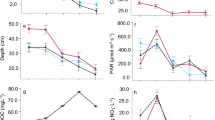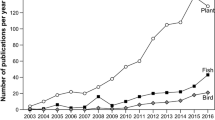Abstract
The role of hydraulic and hydrographic disturbances in delaying, arresting or diverting successional sequences from achieving stable, climactic equilibria is discussed by reference to case studies. The critical time scale is expressed in terms of planktonic reproductive generation times. Environmental constancy persisting over some 12–16 generations may permit a climactic condition to be achieved. An Intermediate Disturbance, if sustained, can establish a new successional sequence or, if not, can lead to a reversion to a sequence similar to the predisturbance succession. At intervals of ∼ 1 generation time, species are selected according to their ability to accommodate disturbances at the physiological level. Highly disturbed environments are considered to be likely to maintain ‘plagioclimactic’ associations.
Similar content being viewed by others
References
Allanson, B. R. & R. C. Hart, 1979. Limnology of P. K. Le Roux Dam. Reports, Rhodes University Institute for Freshwater Studies 11: 1–3.
Berger, C., 1975. Occurrence of Oscillatoria agardhii Gomont in some shallow eutrophic lakes. Verh. int. Ver. Limnol. 19: 2687–2697.
Connell, J. H., 1978. Diversity in tropical rain forests and coral reefs. Science 199: 1302–1310.
Ferguson, A. J. D. & D. M. Harper, 1982. Rutland Water phytoplankton: the development of an asset or a nuisance? In D. M. Harper & J. A. Bullock (eds), Rutland Water — Decade of change. Developments in Hydrobiology 8. Dr W. Junk Publishers, The Hague: 117–133. Reprinted from Hydrobiologia 88.
Ganf, G. G., 1974. Diurnal mixing and the vertical distribution of phytoplankton in a shallow equatorial lake (Lake George, Uganda). J. Ecol. 62: 611–629.
Gaedeke, A & U. Sommer, 1986. The influence of the frequency of periodic disturbances on the maintenance of phytoplankton diversity. Oecologia 71: 98–102.
Gibson, C. E. & A. G. Fitzsimmons, 1982. Periodicity and morphology of planktonic blue-green algae in an unstratified lake (Lough Neagh, Northern Ireland). Int. Revue ges. Hydrobiol. 62: 459–471.
Gibson, C. E., R. B. Wood, E. L. Dickson & M. Jensen, 1971. The succession of phytoplankton in L. Neagh, 1968–1970. Mitt. int. Ver. Limnol. 19: 146–160.
Grime, P., 1979. Plant strategies and vegetation processes. Wiley-Intescience, Chichester.
Grygierek, E. & B. Wasilewska, 1979. Regulation of fishpond biocoenoses. Special Publications of the European Mariculture Society 4: 317–333.
Haffner, G. D., G. P. Harris & M. K. Jarai, 1980. Physical variability and phytoplankton communities. III. Vertical structure in phytoplankton populations. Arch. Hydrobiol. 89: 363–381.
Hamilton, S. K. & W. M. Lewis, 1990. Basin morphology in relation to chemical and ecological characteristics of lakes on the Orinoco River floodplain, Venezuela. Arch. Hydrobiol. 119: 393–425.
Hardin, G., 1960. The competitive exclusion hypothesis. Science. 131: 1292–1297.
Holzmann, R., 1993. Seasonal fluctuations in the diversity and compositional stability of phytoplankton communities in small lakes in upper Bavaria. In J. Padisák, C. S. Reynolds & U. Sommer (eds), Intermediate Disturbance Hypothesis in Phytoplankton Ecology. Developments in Hydrobiology 81. Kluwer Academic Publishers, Dordrecht: 101–109. Reprinted from Hydrobiologia 249.
Hutchinson, G. E., 1961. The paradox of the plankton. Am. Nat. 95: 137–147.
Ibelings, B. W., L. R. Mur & A. E. Walsby, 1991. Diurnal changes in buoyancy and vertical distribution in populations of Microcystis in two shallow lakes. J. Plankton Res. 13: 419–436.
Joint, I. R. & A. J. Pomroy, 1981. Primary production in a turbid estuary. Estuar. coast. mar. Sci. 13: 303–316.
Juhász-Nagy, P., 1993. Notes on compositional diversity. In J. Padisák, C. S. Reynolds & U. Sommer (eds), Intermediate Disturbance Hypothesis in Phytoplankton Ecology. Developments in Hydrobiology 81. Kluwer Academic Publishers, Dordrecht: 173–182. Reprinted from Hydrobiologia 249.
Kilham, P. & S. S. Kilham, 1980. The evolutionary ecology of phytoplankton. In I. Morris (ed.), The physiological ecology of phytoplankton. Blackwell Scientific Publications, Oxford: 571–597.
Kimmel, B. L. & O. T. Lind, 1972. Factors affecting phytoplankton production in a eutrophic reservoir. Arch. Hydrobiol. 71: 124–141.
Kořínek, V., J. Fott, J. Fuksa, J. Lellák & M. Pržáková, 1987. Carp ponds of Central Europe. In R. G. Michael (ed.), Managed Aquatic Ecosystems. Elsevier, Amsterdam: 29–62.
Lewis, W. M., 1978. Dynamics and succession of the phytoplankton in a tropical lake: Lake Lanao, Philippines. J. Ecol. 66: 849–880.
Lindholm, T., 1982. Dynamics of hydrography and primary production in three stratified coastal lakes on Åland (S. W. Finland). Acta Academia Aboensis B 42: 1–75.
Lund, J. W. G., 1949. Studies on Asterionella. I. The origin and nature of the cells producing seasonal maxima. J. Ecol. 37: 389–419.
Lund, J. W. G. & C. S. Reynolds, 1982. The development and operation of large limnetic enclosures in Blelham Tarn, English Lake District and their contribution to phytoplankton ecology. In F. E. Round & D. J. Chapman (eds), Progress in Phycological Research Vol. I. Elsevier, Amsterdam: 1–65.
Margalef, R., 1961. Communication of structure in planktonic populations. Limnol. Oceanogr. 6: 124–128.
Odum, E. P., 1969. The strategy of ecosystem development. Science 164: 262–270.
Pennington, W., 1969. The history of the British vegetation. English Universities Press, London.
Peterson, R., 1975. The paradox of the plankton: an equilibrium hypothesis. Am. Nat. 109: 35–49.
Pickett, S. T. A., J. Kolasa, J. J. Armesto & S. L. Collins, 1989. The ecological concept of disturbance and its expression at various hierarchical levels. Oikos 54: 129–136.
Pollingher, U., 1988. Freshwater armoured dinoflagellates: growth, reproduction strategies and population dynamics. In C. D. Sandgren (ed.), Growth and reproductive strategies of freshwater phytoplankton. Cambridge University Press, New York: 134–174.
Price, P. W., 1984. Alternative paradigms in community ecology. In P. W. Price, C. N. Slobodchikoff & W. S. Gaud (eds), A new ecology: novel approaches to interactive systems. Wiley-Interscience, New York: 353–383.
Priscu, J. C., W. F. Vincent & C. Howard-Williams, 1989. Inorganic nitrogen uptake and regeneration in perennially ice-covered Lakes Fryxell and Vanda, Antarctica. J. Plankton Res. 11: 335–351.
Reynolds, C. S., 1976. The ecology of phytoplankton in Shropshire and Cheshire meres. Report Freshwater Biological Association 44: 36–45.
Reynolds, C. S., 1980. Phytoplankton assemblages and their periodicity in stratifying lake systems. Holarct. Ecol. 3: 141–159.
Reynolds, C. S., 1984. Phytoplankton periodicity: the interaction of form, function and environmental variability. Freshwater. Biol. 14: 111–142.
Reynolds, C. S., 1987a. Community organization in the freshwater phytoplankton. In J. H. R. Gee & P. S. Giller (eds), The organization of communities, past and present. Blackwell Scientific Publications, Oxford: 297–325.
Reynolds, C. S., 1987b. Cyanobacterial Water Blooms. In J. Calow (ed.), Advances in botanical research, Vol. 13. Academic Press, London: 67–143.
Reynolds, C. S. 1987c. The response of phytoplankton communities to changing lake environments. Schweiz. Z. Hydrol. 49: 220–236.
Reynolds, C. S., 1988a. The theory of ecological succession applied to the freshwater phytoplankton. Verh. int. Ver. Limnol. 23: 683–691.
Reynolds, C. S., 1988b. Functional morphology and the adaptive strategies of freshwater phytoplankton. In C. D. Sandgren (ed.), Growth and reproductive strategies of freshwater phytoplankton. Cambridge University Press, New York: 388–433.
Reynolds, C. S., 1988c. Potamoplankton: paradigms, paradoxes, prognoses. In F. E. Round (ed.), Algae and the aquatic environment. Biopress, Bristol: 285–311.
Reynolds, C. S., 1989. Relationships among the biological properties, distribution and regulation of production by planktonic Cyanobacteria. Toxicity Assessment 4: 229–255.
Reynolds, C. S., 1991. Lake Communities: an approach to their management for conservation. In I. F. Spellerberg, M. G. Morris & F. B. Goldsmith (eds), The scientific management of temperature communities for conservation. Blackwell Scientific Publications, Oxford: 199–225.
Reynolds, C. S. & J. W. G. Lund, 1988. Thephytoplankton of an enriched, soft-water lake subject to intermittent hydraulic flushing (Grasmere, English Lake District). Freshwat. Biol. 19: 379–404.
Reynolds, C. S., V. Montecino, M.-E. Graf & S. Cabrera, 1986. Short-term dynamics of a Melosira population in the plankton of an impoundment in central Chile. J. Plankton Res. 8: 715–740.
Reynolds, C. S., J. G. Tundisi & K. Hino, 1983. Observations on a metalimnetic Lyngbya population in a stably stratified tropical lake (Lagoa Carioca, Eastern Brasil). Arch. Hydrobiol. 97: 7–17.
Reynolds, C. S., S. W. Wiseman & M. J. O. Clarke, 1984. Growth- and loss-rate responses of phytoplankton to intermittent artificial mixing and their potential application to the control of planktonic algal biomass. J. appl. Ecol. 21:: 11–39.
Richerson, P., R. Armstrong & C. R. Goldman, 1970. Contemporaneous disequilibrium, a new hypothesis to explain the paradox of the plankton. Proc natn. Acad. Sci. USA 67: 1710–1714.
Round, F. E., 1971. The growth and succession of algal populations in freshwaters. Mitt. int. Ver. Limnol. 19: 70–99.
Smayda, T. J. 1980. Phytoplankton species succession. In I. Morris (ed.), The physiological ecology of phytoplankton. Blackwell Scientific Publications, Oxford: 493–570.
Sommer, U., 1985. Comparisons between steady state and non-steady state competition: experiments with natural phytoplankton. Limnol. Oceanogr. 30: 335–346.
Sommer, U., 1986. The periodicity of phytoplankton in Lake Constance (Bodensee) in comparison to other deep lakes of Central Europe. In M. Munawar & J. F. Talling (eds), Seasonality of Freshwater Phytoplankton — a Global Perspective. Developments in Hydrobiology 33. Dr W. Junk Publishers, Dordrecht: 1–7. Reprinted from Hydrobiologia 138.
Sommer, U., 1989. The role of competition for resources in phytoplankton succession. In U. Sommer (ed.), Plankton ecology. Springer-Verlag, Berlin: 57–106.
Sommer, U., 1993. Disturbance-diversity relationships in two lakes of similar nutrient chemistry but contrasting disturbance regimes. Hydrobiologia 249: 59–65.
Sommer, U., Z. M. Gliwicz, W. Lampert & A. Duncan, 1986. The PEG-model of seasonal succession of planktonic events in freshwaters. Arch. Hydrobiol. 106: 433–471.
Tallis, J. H., 1973. The terrestrialization of lake basins in north Cheshire, with special reference to the development of a ‘Schwingmoor’ structure. J. Ecol. 61: 537–567.
Tansley, A. G., 1939. The British Isles and their vegetation. Cambridge University Press, Cambridge.
Tilman, D., 1982. Resource competition and community structure. Princeton University Press, Princeton.
Tilman, D., S. S. Kilham & P. Kilham, 1982. Phytoplankton community ecology: the role of limiting nutrients. Ann. Rev. Ecol. Syst. 13: 349–372.
Trimbee, A. M. & G. P. Harris, 1983. Use of time-series analysis to demonstrate advection rates of different variables in a small lake. J. Plankton Res. 5: 819–833.
Tundisi, J. G., 1980. Ecológia aquática no Brasil: problemas e perspectives. Interciencia 5: 373–379.
Uhlmann, D., 1971. Influence of dilution, sinking and grazing rate on phytoplankton populations of hyperfertilized ponds and microecosystems. Mitt. int. Ver. Limnol. 19: 100–124.
Vicente, E. & M. R. Miracle, 1988. Physicochemical and microbial stratification in a meromictic karstic lake of Spain. Verh. int. Ver. Limnol. 23: 522–529.
Vincent, W. F., 1981. Production strategies in Antarctic inland waters: phytoplankton eco-physiology in a permanently ice-covered lake. Ecology 62: 1215–1224.
Vincent, W. F., P. J. Neale & P. J. Richerson, 1984. Photoinhibition: algal responses to bright sunlight during diel stratification and mixing in a tropical alpine lake. J. Phycol. 20: 201–211.
Vincent, W. F. & C. L. Vincent, 1982. Factors controlling phytoplankton production in Lake Vanda (77°S). Can J. Fish. aquat. Sci. 39: 1602–1609.
Vollenweider, R. A., 1976. Advances in defining critical loading levels for phosphorus in lake eutrophication. Mem. Ist. ital. Idrobiol. 33: 53–83.
Whitehead, P. G. & G. M. Hornberger, 1984. Modelling algal behaviour in the River Thames. Wat. Res. 18: 945–953.
Zohary, T. & R. D. Robarts, 1989. Diurnal mixed layers and the long-term dominance of Microcystis aeruginosa. J. Plankton Res. 11: 25–48.
Author information
Authors and Affiliations
Rights and permissions
About this article
Cite this article
Reynolds, C.S. Scales of disturbance and their role in plankton ecology. Hydrobiologia 249, 157–171 (1993). https://doi.org/10.1007/BF00008851
Issue Date:
DOI: https://doi.org/10.1007/BF00008851




